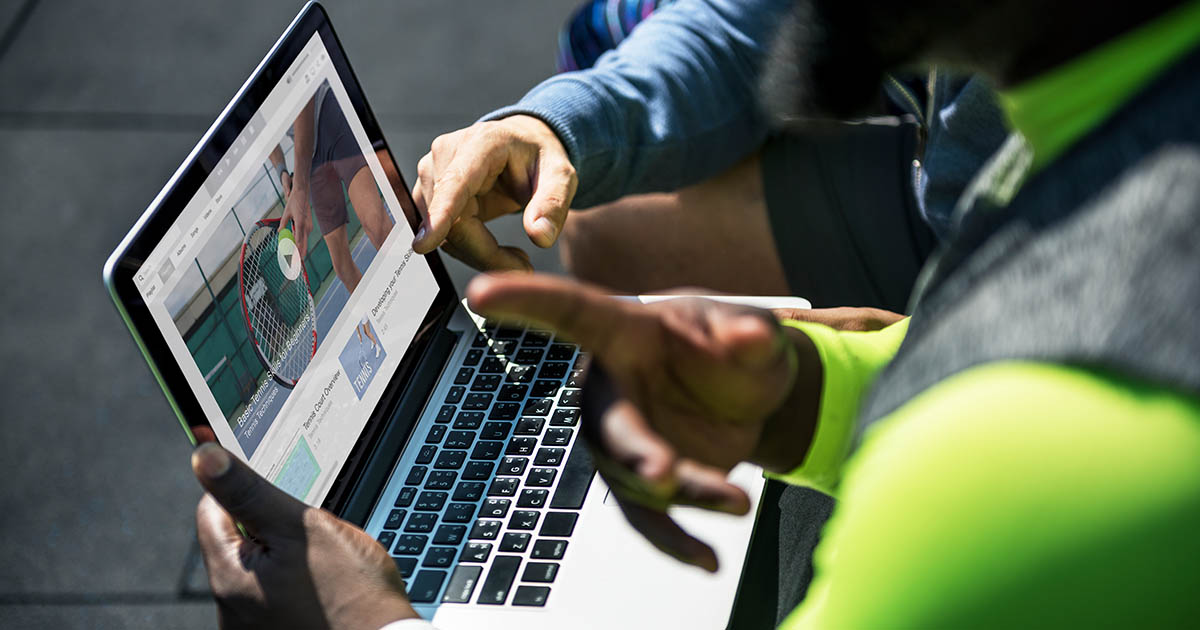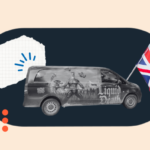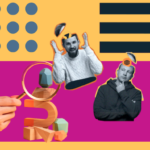How Conversion Funnels Create a Better Customer Journey [+ Tips to Optimize Yours]
- March 29, 2025
- Knowledge Base
- 0 Comments
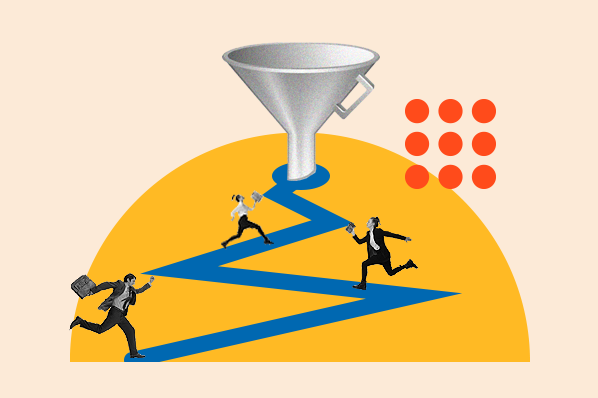
Conversion funnels are a fundamental concept in sales and marketing. Personally, I like to visualize the funnel as that big scary slide you wanted to try as a kid. You saw your friends whizzing down, which sparked your interest. You watched how much fun they were having, doing your research. And then the benefits of having fun outweighed your fear, so you climbed up and flew down.
Customers take a similar journey through your company’s conversion funnel when evaluating whether or not to buy from you. You have to pique their interest, build trust, and encourage them to take action.
In this post, I‘ll explain conversion funnels and how they impact your customer journey. Then, you’ll learn how to optimize your funnel to increase the number of people who make it to your conversion point at the bottom.
Table of Contents
What is a conversion funnel?
A conversion funnel, sometimes called a sales funnel, is a term used to describe the different stages of the buyer’s journey potential customers go through before they take the desired action (i.e., convert). As a salesperson, you guide people through the funnel in order to convert them from potential buyers into customers.
Have you ever watched water swirl through a funnel? If you have, you know that the top of the funnel is wide and becomes smaller at the bottom. The shape of the funnel helps direct the water to a final point.
When moving leads to paying customers, a conversion funnel works the same way as a water funnel.
A conversion funnel is called a funnel because companies often have more leads than they do customers, making the top of the funnel a larger pool of people than the bottom. The top of the funnel, where all leads begin, is broader. As leads move through the funnel, it becomes smaller and more personalized. Your content and customer touchpoints help direct leads to the end of the funnel.
Understanding how people flow through your conversion funnel is essential to being an effective marketer or salesperson. It helps you:
- Engage leads.
- Answer questions about your business.
- Address concerns.
- Organize leads into categories and create customer touchpoints that entice each group to convert.
That’s why every funnel should be designed for how your customers buy, not how you sell. The focus is on providing such a great experience within the customer journey that you convince them to convert.
Before diving into how to analyze and optimize your funnel, we need to talk about an important aspect of this process: the customer journey.
Customer Journey
The customer journey complements the conversion funnel, but it’s not the same thing. Unlike the generalized, linear conversion funnel, customer journey maps show the individual and circuitous paths people take from discovering your brand to purchasing.
Let‘s say you’re a food blogger who sells cookbooks. Here‘s how your customers’ journeys can differ.
- Customer A sees and clicks on your banner ad, visits your blog, reads an article, signs up for your newsletter, gets a discount email, and purchases a cookbook.
- Customer B sees your cookbook in a bookshop, buys it, makes the recipes, visits your blog, and subscribes to your newsletter.
The outcomes for customers A and B are essentially the same, but the journeys and touchpoints are different. So, if you know the various ways people enter your funnel, you can optimize for those entry points. That way, you can meet potential buyers where they are and entice them to convert.
Why Understanding Your Conversion Funnel is Important
To better understand why the conversion funnel is important, I turned to a few experts to get their take. Here’s what they told me.
Belinda Conde, SVP of Marketing at Datos, told me that a conversion funnel is the “holy grail” of any marketing strategy. She uses conversion funnels as a crystal ball to help predict future performance.
Conde said, “[The conversion funnel] is massively important for many companies, but the top of the list for me right now is predicting and, therefore, scaling marketing-attributable revenue. Without historical funnel performance data (especially conversion rates at key stages), it becomes nearly impossible to model future performance accurately.”
Ryan Anderson, President of Markiserv, told me that a conversion funnel is the backbone of both sales and marketing. It becomes even more critical when you want to understand where you can improve your marketing and sales strategies.
Anderson said, “For a product or sales-led business, you are able to identify key drop-off points within the funnel to improve upon whether that is top of funnel (TOFU) or awareness, mid-funnel (MOFU) or consideration/intent, or bottom of funnel (BOFU) or action/purchase based intent.”
Speaking of stages within the conversion funnel, let’s define each stage.
Conversion Funnel Stages
Sales and marketing are full of acronyms. If you hang around either of those departments long enough, you’ll hear references to “TOFU” or ‘BOFU.” These acronyms refer to the various stages of the conversion funnel.
The top-middle-bottom funnel is a classic model used by sales teams. It focuses on sparking interest, informing potential customers, convincing them to purchase, and building loyalty to become repeat buyers.
Traditional Conversion Funnel Stages:
- Top of the funnel (TOFU). This is the awareness phase. Potential customers enter the TOFU when they engage with your brand, oftentimes through your website, an ad, an email, or social media.
- Middle of the funnel (MOFU). This is the consideration phase. Potential customers know about your brand and engage with it to learn more. They may sign up for your email newsletter, follow you on social media, or download guides and templates.
- Bottom of the funnel (BOFU): This is the conversion phase. A prospect is here before they purchase, which means you’ve given them good information and relevant touchpoints. Help them convert by making purchases easy, offering a trial, outlining pricing, or sending a discount for their abandoned shopping cart.
Let’s see what this looks like visually in the examples below.
Conversion Funnel Examples
HubSpot started off with the traditional conversion funnel structure, using marketing efforts to serve as the top of the funnel. Those leads were then passed further down the funnel to the sales team.
While some conversion funnels are simple, others can be incredibly complex. There are several conversion models you can use to suit your business needs, ranging from a simple three-stage funnel for smaller operations to complex, multi-stage sales funnels for enterprise-level companies. Let’s explore some of the most common models.
Three-Stage Marketing Funnel
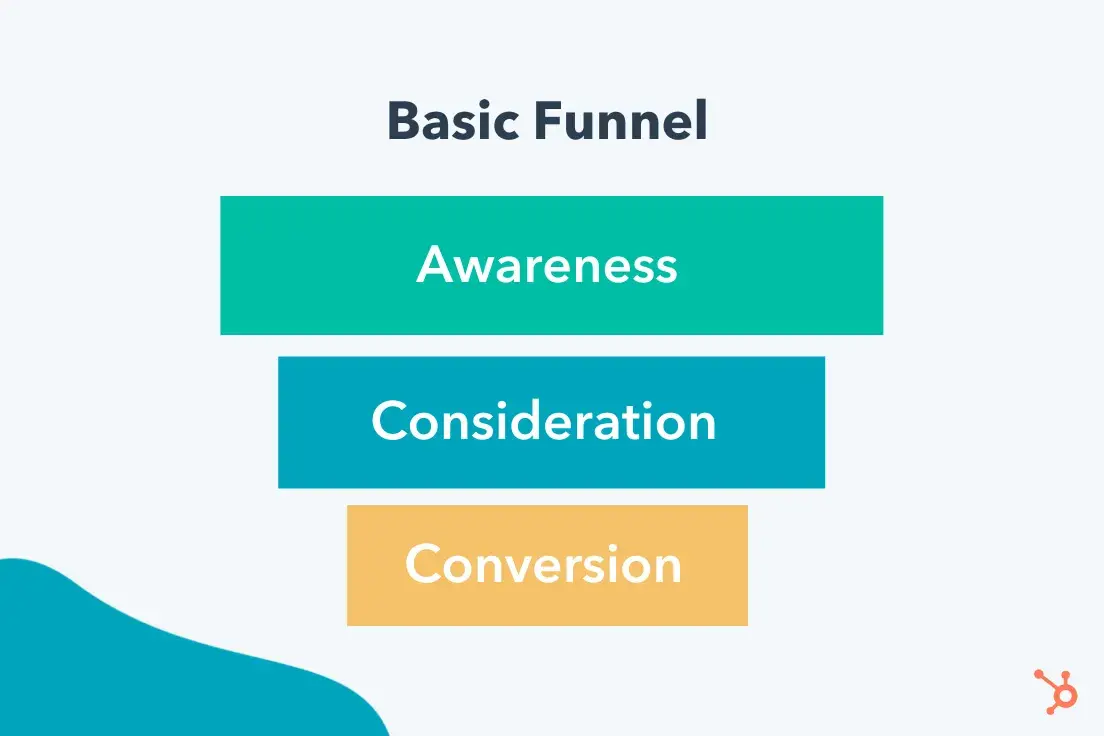
- Awareness: Get visitors to your website. Attract them with quality blog posts or through social media.
- Consideration: Use that great content to entice new visitors to sign up for your newsletter.
- Conversion: Now that prospects are familiar with your brand, persuade them to purchase by offering a discount code for first-time buyers.
AIDA Funnel
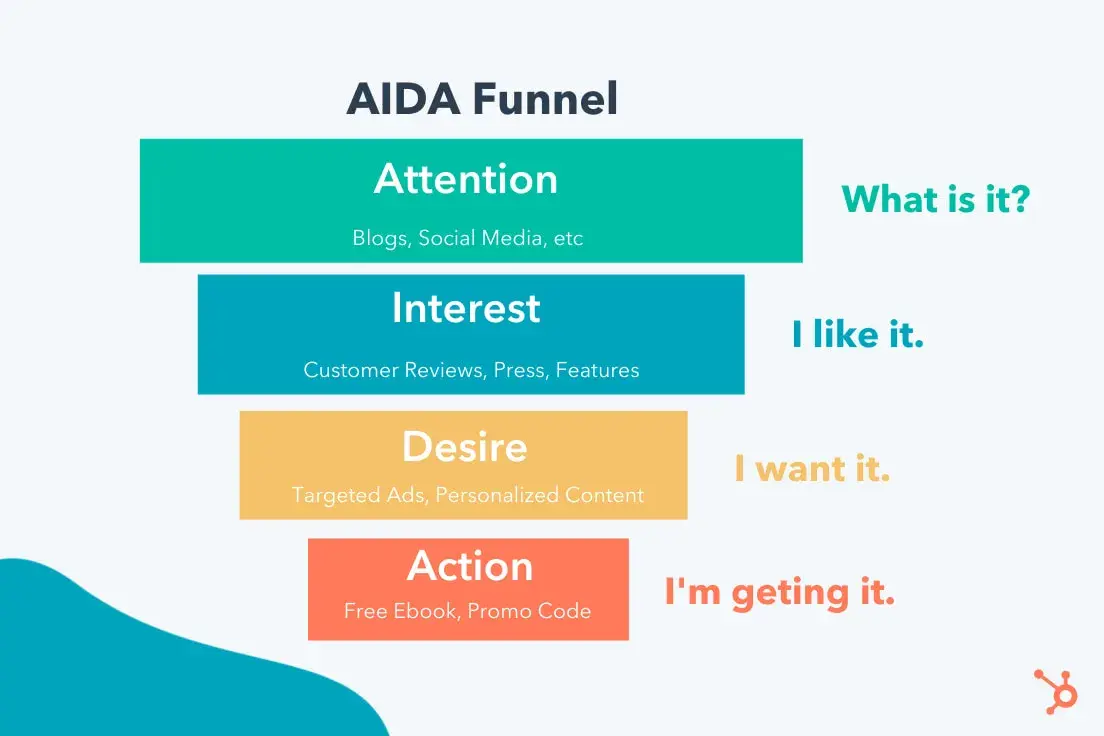
Sometimes called a “purchase funnel,” the AIDA model expands on the basic three-stage structure.
- Attention: Besides blog posts and social media, you can use targeted ads to draw visitors to your website.
- Interest: Pique the prospect’s interest in your product by showcasing the goods. Use case studies to show how your product has helped other businesses. Have notable press mentions? You’ll want to showcase those as well.
- Desire: Your prospects like you. Now, you must make them want you. Gain their trust and create an emotional connection. Continue to serve them content that helps them visualize how your product would fit into their lives and why they need it.
- Action: Now’s your chance to get them to convert. One way is to offer a free ebook, trial, or tool that is only accessible if they fill out a form with their contact information. If your goal is to get them to purchase a product, you could give them a promotional offer to persuade them to buy.
The detail of your funnel depends on your sales process — the longer your sales cycle, the more complex your funnel. If you have a short sales cycle, your funnel tends to be simpler.
Think about how long it takes to sell $2,000 B2B software versus a $20 T-shirt. The software purchase usually requires months of sales calls, marketing materials, FAQs, and demos.
Each of those is a specific point in your conversion funnel. However, potential buyers may only need five minutes to determine whether the t-shirt is the right color and fit before purchasing. The touchpoints required here are taking it off the rack and trying it on.
Action: Jot down a list of your current strategies that help build brand awareness, drive lead consideration, or convert a prospect to a customer. For example, do you run paid social media ad campaigns? Do you offer free trials or provide one-on-one consultations with your sales team?
This list will help you begin to understand your conversion funnel. And to figure out how complex your funnel is, you can look at the data and perform an analysis. This will help you flush out each part of your customer journey to create a unique visual representation of your funnel.
Conversion Funnel Analysis
Analyzing your funnel helps you visualize the flow of potential customers across each point. You can see key traffic sources and high-exit pages to get a feel for how people end up in each stage of the funnel.
Looking at your funnel also helps you uncover barriers and points of friction that cause people to leave a page before they convert. For example, if you see a high drop-off rate on one page, you’ll know to prioritize that as you work toward optimizing your funnel.
To understand your funnel, follow these steps for in-depth analysis:
1. Look for high-traffic pages with high drop-off and conversion rates.
High-traffic pages hold a plethora of helpful information. Not only are these the pages people see the most, but they’re also where people decide to stay or go. Look at the pages where people drop off (aka leave) and where they convert (take your intended action). Some metrics to collect are:
- Cost Per Acquisition (CPA)
- Customer Lifetime Value (CLV)
- Drop-Off Rate
- Conversion Rate
- Number of Marketing Qualified Leads (MQLs)
- MQLs to Customer Conversion Rate
- Conversion Rate Per Channel (i.e., social, email, and paid search)
Action: Monitor these metrics for at least a quarter. Track your numbers in a spreadsheet to help make auditing easier, or use a custom funnel report. For better visualization, create a graph.
2. Discover where your best customers come from.
Not all leads are the same. Some people drop off near the top of the funnel, while others make it all the way down. That‘s why tracking leads is so important. When you know where your high-quality leads come from, you can analyze that touchpoint or channel to see what you’re doing right.
Ask yourself:
- How is this touchpoint different from other touchpoints?
- What information is resonating with people?
- What are the barriers or friction (if any)?
- How many steps do people have to go through before converting?
Identifying what you‘re doing right in your funnel is just as important as figuring out what you’re doing wrong.
Action: If you need help digging into the data, check out these sales funnel tools or look into heatmap and session recording tools for information on how people navigate your pages.
3. Create an optimization plan.
After you figure out where people are dropping off and converting, it’s time to make an optimization plan. This should include the goals you want to focus on, like more:
- Leads
- Newsletter signups
- Demos
- Software purchases
Goals let you determine what you want from each touchpoint within your funnel so you can measure whether it’s working or not.
After your funnel analysis, you’ll have a list of priority touchpoints that need to be optimized. Make sure to focus on the areas with the most significant drop-off rates first.
Pro tip: To optimize your funnel, make one meaningful change at a time. Singular changes help you understand what’s working and what’s not.
Benefits of Optimizing Your Conversion Funnel
Your conversion funnel is only as good as the strategies you use to build it. Without solid strategy, your leads will quickly drop out of the funnel and will be reluctant to re-engage.
Optimization is crucial — it brings better results with less effort. Let’s look at the positives of taking the time to optimize your conversion funnel.
1. Increased Conversions
An optimized conversion funnel leads to, well, more conversions.
Take Anderson and his team. After optimizing their funnels, they saw improved conversions on their customer registration pages and MQLs.
“We removed barriers to conversion along our funnel, wherein TOFU users were having trouble registering in our funnel, becoming intent-based users, or MOFU, based on a frustrating form fill process,” Anderson said.
Here’s what he and his team did to improve their conversion rates:
- Eliminated large form-fill fields, which improved bounce and exit rates
- Increased TOFU video content to garner more interest.
“This, in turn,” he said, “increased the amount of MQLs that entered our pipeline and MOFU prospects for us to service. Once our MOFU pipeline expanded, this increased our BOFU counts and conversion rates.”
2. Lower Customer Acquisition Costs
One of the biggest benefits of improving your conversion funnel is reducing customer acquisition costs (CAC). CAC refers to how much a brand spends to gain a new customer.
Let’s look at a quick example. Let’s say you analyze your funnel and realize that more of your leads come from social media ads than any other source. Using this information, you can invest more in social media marketing and decrease your spending on other avenues that don’t provide the same results.
While you might spend more on one marketing channel, you’ll save more of your marketing budget by nixing ineffective strategies.
3. Better User Experience
Optimizing the touchpoints in your conversion funnel leads to a better user experience. When leads are pleased with their initial experiences with your brand, they’ll continue to move through the conversion funnel.
Your website is among the first places a lead might interact with your brand. A slow-loading website is a major turn-off for many leads, meaning they’ll bounce off your page and onto something else.
Nearly 18% of visitors become frustrated with slow loading pages. When you improve your website speeds, you reduce your bounce rate and shuffle your leads to the next part of your funnel, like the call-to-action (CTA).
If the next phase of the funnel is personalized to your target audience, even better—especially considering that personalized CTA performs a whopping 202% better than generic CTAs.
Pro tip: 70% of marketers believe that A/B testing is essential to boost conversion rates. Use A/B testing to nail your messaging across your website and CTAs.
4. Better ROI
Optimizing your conversion funnel often means being very specific in your messaging. The more laser-focused your messaging, the better it resonates with the leads who will become customers.
Effective messaging is essential for a better ROI. Brands who nail personalized messaging often see over 120 times better ROI compared to brands who focus on creating marketing campaigns for a broader audience.
5. A Realistic Sales Pipeline
I asked Conde what she thought was the biggest benefit of a conversion funnel. She told me her conversion funnels help identify high-value leads and create more realistic pipelines tailored to a specific audience.
“The most significant benefit would be having a more realistic pipeline for marketing and sales. Last year, my team and I worked really hard to refine our HubSpot Lead Scoring logic to narrow down what really constitutes a valuable MQL. We needed to better profile leads that were genuinely aligned with our ICPs and map out all the implicit and explicit attributes that would demonstrate intent or engagement,” she said.
“That naturally led to a decrease in the number of MQLs in our pipe, but we ended up having a much cleaner and highly qualified funnel. Over time, we’re pleased with the results, and the conversion rates down the funnel are more realistic, allowing us to monitor any anomalies much more efficiently.”
Conversion Funnel Optimization
Every part of your conversion funnel can be optimized to increase the number of people who turn into customers. Think of conversion funnel optimization as finding out what motivates, blocks, and persuades people so you can give them the best experience possible on their unique journey.
To optimize effectively, you need to think about giving each customer what they want at each phase of the funnel. Using the phases outlined above, here’s what to consider at each step along the customer journey.
1. TOFU: Awareness
Issues at the top of your funnel? Take a look at how you attract new leads. Compare every channel that brings in customers (i.e., social media, search engines, your blog, and paid ads) to see which attracts the most people.
Action: If you‘re unsure how customers found you, send out a survey to ask. Look for trends in how people find new brands and put more effort into your best channels. This helps make sure you’re attracting the people in your target audience.
2. MOFU: Consideration
Potential customers made it to the middle of your funnel, but it’s your job to keep them moving toward the bottom.
If you’re having trouble with this phase, look at how people learn about your business and engage with your site.
Action: Ask yourself the following questions.
- Is it easy for people to navigate your site? Or sign up for your email list?
- Do you have relevant, rich content?
- Do you offer pricing and product information?
- Is it easy to get questions answered?
Depending on your barriers, consider these ideas for improvement:
- Product videos and photos
- FAQ page
- Whitepapers, case studies, or blog posts
- Filters and search options
- Newsletter capture
- Discounts
- Check pages for loading speed and broken elements
3. BOFU: Conversion
As the final stop for potential buyers, this is the phase to turn them into customers. You should remove as much friction as possible and encourage people to take the final steps to convert.
Some ways to optimize this final part of your funnel are to make sure product or service pages are fully built out with:
- Interesting descriptions.
- Engaging videos.
- High-quality images and photos.
Consider your checkout process to see if people have issues with payments or abandoned carts. Make it simple for people to compare pricing and clearly outline all product features. You can also send specific BOFU emails or create ads to remind people of their desire to convert.
Think your job is done once a customer converts? Wrong.
While you may have pulled a customer through your conversion funnel, there are plenty of opportunities to re-engage them. Not only is customer retention essential for growing your business, but it’s often more expensive to acquire a new customer than to retain a current customer.
Action: Once your customers make it through the funnel, re-engage them. You can invite them to:
- Sign up for a new webinar series.
- Download additional templates.
- Send promotions.
- Join a loyalty club.
- Follow you on social media.
Conversion Funnels Shouldn’t Be Business Models
While conversion funnels are very effective for demonstrating the customer journey for a one-time purchase, they are not a substitute for creating a holistic business model. Relying on a funnel as your business model creates a lack of alignment between each stage of the customer experience.
HubSpot transitioned to thinking of the customer journey as less of a funnel and more of a flywheel — building more momentum as customers move through it.
With the flywheel model, the momentum of your happy customers is used to drive referrals and repeat sales. It’s not a linear beginning and end, but rather a continuous cycle that allows you to generate more business.
Tailor Your Funnel to the Customer
While the customer journey is more complex than my slide analogy, understanding how conversion funnels work can improve this flow. It can help you optimize your funnel, attract more leads, convert them to customers, and boost your bottom line. But all that requires reducing as much friction as possible.
My advice: Find what makes sense for your particular sales cycle and use your existing content and channels to stay in touch. Make sure customers value your business and want to come back because you never know who they’ll introduce to the top of that funnel.
Editor’s note: This post was originally published in April 2021 and has been updated for comprehensiveness.
